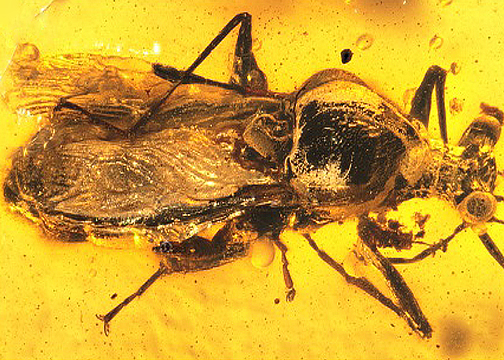Abstract
Based on an exquisitely preserved Yuripopovinidae specimen, a new genus and species, Tumpectus triporcatus gen. et sp. nov. is described and illustrated. The new genus has a unique vein pattern in the forewings, and we discuss the forewing veins features of the Yuripopovinidae. Furthermore, the new genus also has some interesting features that are different from other genera, comparison between the new species and other fossil genera in the Yuripopovinidae is provided.
References
- Azar, D., Nel, A., Engel, M.S., Garrouste, R. & Matocq, A. (2011) A new family of Coreoidea from the Lower Cretaceous Lebanese amber (Hemiptera Pentatomomorpha). Polish Journal of Entomology, 80, 627–644. https://doi.org/10.2478/v10200-011-0049-5
- Chen, S., Deng, S.W., Shih, C.K., Zhang, W.W., Zhang, P., Ren, D., Zhu, Y.N. & Gao, T.P. (2018) The earliest timematids in Burmese amber reveal diverse tarsal pads of stick insects in the mid-Cretaceous. Insect Science, 26 (5), 945–957. https://doi.org/10.1111/1744-7917.12601
- Damen, W.G.M., Hausdorf, M., Seyfarth, E.A. & Tantz, D. (1998) A conserved mode of head segmentation in arthropods revealed by the expression pattern if Hox genes in a spider. Proceedings of the National Academy of Sciences of the United States of America, 95 (18), 10665–10670. https://doi.org/10.1073/pnas.95.18.10665
- Du, S.L., Yao, Y.Z., Ren, D. & Zhang, W.T. (2017) Dehiscensicoridae fam. nov. (Insecta: Heteroptera: Pentatomomorpha) from the Upper Mesozoic of Northeast China. Journal of Systematic Palaeontology, 15 (12), 991–1013. https://doi.org/10.1080/14772019.2016.1259665
- Du, S.L., Hu, Z.K., Yao, Y.Z. & Ren, D. (2019) New genus and species of the Yuripopovinidae (Pentatomomorpha: Coreoidea) from mid-Cretaceous Burmese amber. Cretaceous Research, 94, 141–146. https://doi.org/10.1016/j.cretres.2018.10.022
- Fabrikant, D. & Novoselska, T. (2024) A peculiar large-eyed aposematic bug Miropictopallium coloradmonens n. gen., n. sp. (Heteroptera: Pentatomomorpha: Yuripopovinidae) from mid-Cretaceous Kachin amber. Israel Journal of Entomology, 53, 1–23.
- http://dx.doi.org/10.5281/zenodo.10848699
- Hughes, C.L. & Kaufman, T.C. (2002) Hox genes and the evolution of the arthropod body plan. Evolution & Development, 4 (6), 459–499. https://doi.org/10.1046/j.1525-142X.2002.02034.x
- Kóbor, P. & Roca-Cusachs, M. (2021) Pseudocaulisoculus longicornis: description of a new yuripopovinid true bug from mid-Cretaceous Burmese amber (Heteroptera: Coreoidea: Yuripopovinidae). Cretaceous Research, 125, 104849. https://doi.org/10.1016/j.cretres.2021.104849
- Latreille, P.A. (1810) Considérations générales sur l’ordre naturel des animaux. composant les classes des crustacés, des arachnides, et des insectes. F. Schoell, Paris, 444 pp. https://doi.org/10.5962/bhl.title.39620
- Leston, D., Pendergrast, J.G. & Southwood, T.R.E. (1954) Classification of the terrestrial Heteroptera (Geocorisae). Nature, 174, 91–94. https://doi.org/10.1111/j.1365-3032.1956.tb00214.x
- Leston, D. (1956) The Ethiopian Pentatomoidea (Hemiptera): ⅩⅫ, on Dismegistus Amyot and Serville (Cydnidae). Proceedings of the Royal Entomological Society of London (A), 31 (7–9), 87–94.
- Li, H.Y., Zhuo, D., Nakamine, H., Yamamoto, S., Zhang, W.W., Ling, L., Ohl, M., Aspöck, U., Aspöck, H. & Liu, X.Y. (2023a) New generaand species of Mantispoidea (Insecta, Neuroptera) from the mid-Cretaceous Kachin amber, Myanmar. Palaeoentomology, 6 (6), 549–611. https://doi.org/10.11646/palaeoentomology.6.6.1
- Li, L.F., Rasnitsyn, A.P., Shih, C.K., Labandeira, C.C., Buffington, M., Li, D.Q. & Ren, D. (2018) Phylogeny of Evanioidea (Hymenoptera, Apocrita), with descriptions of new Mesozoic species from China and Myanmar. Systematic Entomology, 43, 810–842. https://doi.org/10.1111/syen.12315
- Li, X.Q., Rasnitsyn, A.P., Gao, J., Zhang, Y.J., Shih, C.K., Ren, D., Zhao, Y.Y. & Gao, T.P. (2023b) New taxa of Sepulcidae (Hymenoptera) from mid-Cretaceous Kachin amber. Palaeoentomology, 6 (2), 133–145. https://doi.org/10.11646/palaeoentomology.6.2.5
- Linnaeus, C. (1758) Systema naturae per regna tria naturae secundum classes ordines, genera, species, cum characteribus differentiis synonymis, locis. Tomus I. Editio decimo, reformata. L. Salvius, Holmiae [= Stockholm], 824 pp. https://doi.org/10.5962/bhl.title.542
- Tsai, J.F. & Rédei, D. (2010) Taxonomical notes on Oriental and Pacific jewel bugs (Hemiptera: Heteroptera: Scutelleridae). Zootaxa, 2572, 25–47. https://doi.org/10.5281/zenodo.197410
- Shi, G.H., Grimaldi, D.A., Harlow, G.E., Wang, J., Wang, J., Yang, M., Lei, W.Y., Li, Q.L. & Li, X.H. (2012) Age constraint on Burmese amber based on U-Pb dating of zircons. Cretaceous Research, 37, 155–163. https://doi.org/10.1016/j.cretres.2012.03.014
- Shang, T.T., Wang, X.L., Zhang, L.X. & Chen, J. (2020) A tiny yuripopovinid true bug (Hemiptera, Pentatomomorpha) from Cenomanian Burmese amber. Cretaceous Research, 114, 104534. https://doi.org/10.1016/j.cretres.2020.104534
- Štys, P. (1964) Thaumastellidae–a new family of pentatomoid Heteroptera. Časopis Československé Společnosti Entomologické, 61, 238–253.
- Sohn, J.C. & Nam, G.S. (2024) New fossil genus and species of Yuripopovinidae (Insecta: Heteroptera, Coreoidea) from the Lower Cretaceous Jinju Formation, South Korea, with insights into the evolution of exaggerated antennae in the family. Cretaceous Research, 158, Art. 105847. https://doi.org/10.1016/j.cretres.2024.105847
- Schuh, R.T. & Weirauch, C. (2020) True bugs of the world (Hemiptera: Heteroptera). Classification and natural history. 2nd edition. Siri Scientific Press, Manchester, 768 pp.
- Yang, H.R., Yin, X.C., Lin, X.D., Wang, C., Shih, C.K., Zhang, W.W., Ren, D. & Gao, T.P. (2019) Cretaceous winged stick insects clarify the early evolution of Phasmatodea. Proceedings of the royal society B, 286, 20191085. https://doi.org/10.1098/rspb.2019.1085
- Yu, S., Chen, J. & An, B.Z. (2024) Birmaniaespina robustispina gen. et sp. nov., a new yuripopovinid bug from Cenomanian Kachin amber, Myanmar (Hemiptera, Pentatomomorpha). Cretaceous Research, 155, Art. 105772. https://doi.org/10.1016/j.cretres.2023.105772
- Zhang, J.Q. & Chen, J. (2020) A stalk-eyed true bug in mid-Cretaceous Burmese amber (Hemiptera, Pentatomomorpha, Yuripopovinidae). Cretaceous Research, 110, 104391. https://doi.org/10.1016/j.cretres.2020.104391
- Zhang, X, Ren, D. & Yao, Y.Z. (2017) A new species of Foveopsis Shcherbakov (Hemiptera: Fulgoromorpha: Fulgoroidea: Perforissidae) from mid-Cretaceous Burmese amber. Cretaceous Research, 79, 35–42. https://doi.org/10.1016/j.cretres.2017.07.002
- Zhang, Y.J., Rasnitsyn, A.P., Zhang, W.T., Song, F., Shih, C.K., Ren, D., Wang, Y.J., Li, H. & Gao, T.P. (2024) Stem chewing lice on Cretaceous feathers preserved in amber. Current Biology, 34, 1–7. https://doi.org/10.1016/j.cub.2024.01.027
- Zhou, Y.Y., Luo, J.Y., Xie, Q. & Li, Z.Q. (2022) A new fossil genus and species of Coreoidea (Hemiptera: Heteroptera) from mid-Cretaceous Burmese amber. Cretaceous Research, 135, 105211. https://doi.org/10.1016/j.cretres.2022.105211
- Zhuo, D., Chen, J., Yu, S., Zheng, Y., Ren, G.Y., An, B.Z. & Yang, F. (2022) A new yuripopovinid bug from Cenomanian Burmese amber (Hemiptera, Pentatomomorpha). Cretaceous Research, 135, 105206. https://doi.org/10.1016/j.cretres.2022.105206


